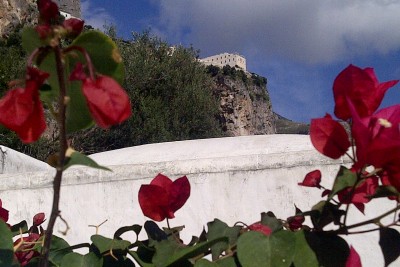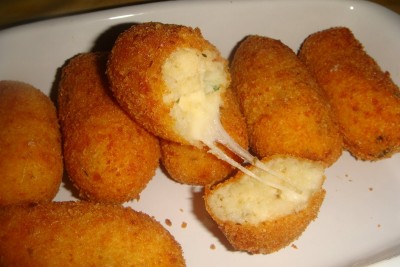The Amalfi Coast Cuisine, Rooted in Centuries of Culinary Traditions
What they cook now comes directly from the ancestors
Food traditions About two thousand years ago the Romans populated the Gulf of Naples and settled in the beautiful towns of Pompeii, Herculaneum, Cuma, Baia and Sorrento, and inhabited the villas along the Amalfi Coast.
Since then the local gastronomic tradition begun with the Romans has been handed down by word of mouth over the centuries.
Some of the recipes were described in "De Re Coquinaria", a collection of Roman recipes, such as the vinegar sauce scapece used by the people of Cetara to honor their patron saint St Peter on his feast day.
In the 17th century the local cuisine met the tomato, inspiring the imagination of the housewives and prompted them to transform simple dishes into delicious food. Many of the local dishes took on a red hue, such as the "parmigiana di melanzane", the pasta with beans and the spaghetti with clams, which assumed a pink color from the use of cherry tomatoes.
Grain and Vegetables
After they decided to settle in the area, the Romans started growing spelt (a kind of grain that they separated from the chaff by burying it on big, hot stones), wheat, beans, chickpeas and vegetables.
These products fed the people of Amalfi Coast for centuries and have been handed down in their best combinations.
The spelt soup with chickling or beans flavored with lard comes to mind. Historically local monks used these produces for the many soups they invented, such as "minestra maritata" (soup with meat and vegetables), dried broad bean soup, chickpea and mushroom soup and chestnut soup.
Anchovies
The tradition of the "colatura di alici" (or draining of the liquid from salted anchovies) probably started around the second half of the 13th century.
It was done by the Cistercian monks in the old canonical in San Pietro a Tuzolo, on a hill near Amalfi.
As they had a small fleet of boats mainly used for the transport of wheat but also, in the summer months, for fishing of anchovies, the monks built up a small industry for the preservation of the catch.
The heads and part of the interiors were removed and the fish were washed in seawater. They were then placed with layers of salt in old wine casks that could no longer be used. The casks were finally placed on two parallel beams of chestnut wood.
At the beginning of December the salt and the large stone used as a press had preserved the fish and eliminating its liquid, which had flowed through the staves, dripped onto the floor and gave off a different smell from the one produced by the anchovies before preservation.
This new, pleasant smell, and the transparency and amber color of the liquid prompted the monks to collect it and submit it to the verdict of their cook.
Understanding the importance of this new discovery, the cook used it on the boiled vegetables usually served with garlic, red pepper, olives, capers and olive oil.
The monks then collected so much of this special liquid that they sent it as gifts to the convents in the area. People in the surrounding areas subsequently started to produce the liquid at home.
Unfortunately Amalfitan families no longer salt the anchovies and so no longer filter the residue of the vases to make colatura.
The people of Cetara are the only ones to do this. With great devotion to this ancient tradition, they filter the residue of the vases of mature anchovies. Nowadays the colatura of Cetara is served with linguine pasta with the addition of red and black pepper, green olives, capers, parsley, garlic and a squeeze of lemon juice mixed together a few hours before adding it to the drained pasta. /p>
Caponata
This well-known regional dish is a direct descendant of "custrum", the hard wheat and barley meal bread soaked in water normally served with salted fish, capers, olives, bay leaves and oil.
The caponata was served as a main course by the "caupo", the host of the crowded "caupona viaria", the street lined with taverns.
Pasta
Pasta probably arrived in Italy in the 11th century from the Middle East, first becoming popular in Venice, Genoa and Amalfi and then spreading to the rest of the country.
The first pasta shapes on the Amalfi Coast were probably "ndunderi", "lagane" and "ricci" created by housewives and passed on by the master pasta makers.
"Ndunderi" is the natural descendant of "polenta caseata di farro", flour mixed with milk curdled with fig latex, made into smalls balls and cooked in boiling water.
They was served with cheese and herbs or a cold sauce made of parsley, garlic, fennel seeds, pecorino cheese, salt, walnuts and extra virgin olive oil. The pasta still exists in Minori today, although no longer with its traditional shape and sauces.
Pastry
The people of Campania transformed simple sweet dishes into culinary works of art.
"Zeppole" (doughnuts), "struffoli" (small balls offried doughnut mixture covered with honey) and "mustaccioli" (diamond-shaped biscuits) were made to celebrate Christmas.
The "Pastiera" is an Easter cake, originally made from a mixture of leftover pasta with sweetened ricotta, eggs and cinnamon and later made with a long, thin pasta called "fedeline" cooked in milk and flavored with sugar, cinnamon and orange blossom water and mixed with beaten egg.
The recipe has changed over the centuries and the modern pastiera has a case of shortcrust pastry filled with a mixture of custard, whipped sweetened ricotta, chopped candied lime and orange peel. The sfogliatella was created by the nuns in the Santa Rosa Monastery in Conca dei Marini at the beginning of the 18th century.
It was one of those days every two weeks when the bread for the monastery was made.
They had some semolina cooked in milk and sweetened that the cook had prepared for the old or ill sisters. It was mixed with dried apricots, pears and plum. The fruit was soaked in lemon liqueur. This tasty mixture was then placed on a "pettola" (sheet of pastry) that the monks had used to make the bread.
The "pettola" was a well-kneaded mixture of lard, sugar and a little aged white wine to make a delicate flaky pastry.
Another sheet of pastry was placed on top of the mixture, it was shaped by hand to resemble a monastic hood, placed on a wooden board and baked in a hot oven.
The Mother Superior, greatly appreciating this new invention, decided to call it Santa Rosa in honor of the founder of the order.
She ordered it to be made in sufficient quantities to give to all the families in the town and to the benefactors in the other towns along the coast and in Naples.
Over time there have been some changes in the ingredients and the shape. Dried fruit has been substituted by candied peel and the pastry has been made smaller.


